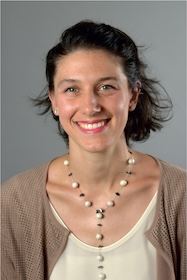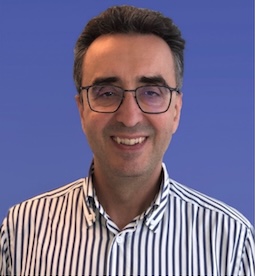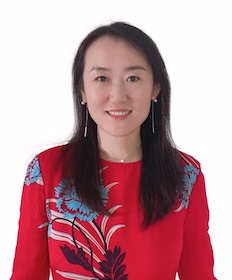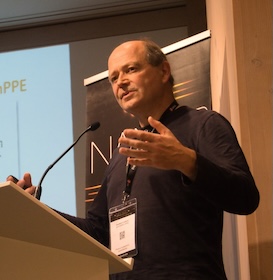Lectures

Alexander O. Govorov
Department of Physics and Astronomy, Ohio University, Athens, USA; govorov@ohio.edu
Lecture : Short Stories from the World of Optical Metamaterials: DNA-Origami, The Origin of Chirality, Chiral Plasmonic Photochemistry, and More
Seminar: "Hot Electrons and Electromagnetic Effects in Achiral and Chiral plasmonic nanostructures"
Chirality refers to objects whose geometry is such that the mirror image cannot coincide with the object [1]. Numerous molecular and biomolecular systems of prime importance are chiral (e.g., DNA, sugar, lactic acid, proteins). Recently, the fields of plasmonics and bio-photonics have begun to actively involve the concept of chirality. Why plasmonics? This talk will address this point.
Plasmonic nanostructures and metamaterials are very efficient at the absorption and scattering of light. The studies presented in this talk concern unique designs of hybrid nanostructures with electromagnetic hot spots, where the electromagnetic field becomes strongly enhanced and spatially concentrated [2-12]. In particular, nanocrystal assemblies and metastructures with plasmon resonances can be designed to be strongly chiral, demonstrating unprecedented numbers of Circular Dichroism (CD) for a nanoscale system [9]. Simultaneously, when conjugated with biomolecules, plasmonic hot spots allow us to enhance chiral optical responses (CD) of biomolecular species, whereas, in an inorganic environment, plasmonic nanocrystals are efficient at inducing chiral photochemical effects [8-12].

[1] W. T. B. Kelvin. The molecular tactics of a crystal, Clarendon Press Oxford (1894).[2] E.-M. Roller et al., Nature Physics, 13, 761 (2017).[3] A. O. Govorov, H. Zhang, H.V. Demir and Y. K. Gun’ko, Nano Today 9, 85 (2014). [4] H. Harutyunyan et al., Nature Nanotech. 10, 770 (2015). [5] A. O. Govorov and H. Richardson, Nano Today 2, 20 (2007). [6] C. Jack et al., Nat. Commun. 7, 10946 (2016). [7] X.-T. Kong et al., Nano Letters, 18, 2001 (2018).[8] A. O. Govorov et al., Nano Letters 10, 1374–1382 (2010). [9] A. Kuzyk et al., Nature 483, 311 (2012). [10] T. Liu et al., Nano Letters, 19, 1395–1407 (2019). [11] K. Martens, et al., Nat. Commun., 12, 2025 (2021). [12] S. Rej, A. Naldoni, et al., Nano Energy, 104(B), 107989 (2022).

Giulia Tagliabue
EPFL, Laboratory of Nanoscience for Energy Technologies, Lausanne, Switzerland
Lecture: Nanophotonics for Energy: an Opportunity for Photochemical Devices
Seminar: Nanophotonic Engineering for Light-Energy Storage Devices
In the last decade, optical nanoantennas have revolutionized light manipulation and control at the nanoscale. Interestingly, generation of hot carriers in metals upon light absorption have opened new pathways for controlling activity and selectivity of photo(electro)chemical processes. Concurrently, semiconductor nanostructures enable optimization of charge transport and light absorption. Yet, fundamental questions remain about the microscopic details of these complex light-matter interactions. I will first present our recent results on quantifying the energy-resolved injection probability of hot electrons and hot holes across the metal/semiconductor interface. We demonstrate the importance of small scale nanoantennas to maximize the chance of ballistic collection and we unravel microscopic details of charge transfer via inner or outer sphere pathways [1,2]. Furthermore, I will show how morphology of semiconducting nanostructures dramatically impacts the performance of solar redox flow batteries [3]. In particular, we demonstrate that high photovoltages are attainable in single-material photoanode, enabling unassisted recharging up to high state of charge. Overall, using an internal quantum efficiency perspective, our work unravel the interplay of light absorption, charge generation and in plasmonic and semiconducting photocatalysts.

Giulio Cerullo
Physics Department,Ultrafast Spectroscopy Group, Politecnico di Milano, Itally
Lecture: Ultrafast hot electron dynamics in plasmonic nanostructures
Seminar: Ultrafast processes in 2D semiconductors and their heterostructures
Layered materials consist of crystalline sheets with strong in-plane covalent bonds and weak van der Waals out-of-plane interactions. These materials can be easily exfoliated to a single layer, obtaining two-dimensional (2D) materials with radically novel physico-chemical characteristics compared to their bulk counterparts. 2D semiconductors such as transition metal dichalcogenides (TMDs) exhibit very strong light-matter interaction and exceptionally intense and ultrafast nonlinear optical response, enabling a variety of applications in optoelectronics and photonics. Furthermore, stacking TMDs into heterostructures (HS) offers unlimited possibilities to design new materials tailored for applications
This talk will review our recent studies on the ultrafast non-equilibrium optical response of TMDs and their HS. Using high time resolution ultrafast transient absorption (TA) spectroscopy, we monitor the ultrafast onset of exciton formation in TMDs and the dynamics of strongly coupled phonons. Using helicity resolved TA spectroscopy we time-resolve and control intravalley spin-flip processes. In HS of TMDs we time-resolve ultrafast interlayer hole transfer and interlayer exciton formation processes. We also show that strong exciton nonlinear interactions can lead to a complete quenching of the Rabi splitting in TMD-based microcavities.
Javier Aizpurua
Donostia International Physics Center (DIPC), and University of the Basque Country (UPV/EHU), Theory of Nanophotonics Group, San Sebastian, Spain
Lecture: Nano-cavities and Strong Coupling
Seminar: Exploiting picocavities in field-enhanced fluorescence and in surface-enhanced Raman scattering
Plasmonic nanocavities provide a remarkable effective mode volume reduction, with the corresponding localization and enhancement of local electromagentic fields. A particularly useful extra-localization of light due to the presence of atomic protrusions in surfaces and metallic tips, so-called picocavities, provides the ultimate paradigm of light localization, boosting light-matter interaction at the atomic scale. The extreme fields produced in picocavities can be exploited in field-enhanced spectroscopy and microscopy for instance to reach strong coupling regimes of light-matter interaction as well as to achieve extreme resolution in spatially-resolved molcecular excitations mapping, as in flurescence or in Raman scattering. A description of picocavity-assisted molecular fluorescence of organic chromophores, as well as molecular optomechanical effects driven by a picocavity on a metallic tip will be provided with a strong connection to state-of-the-art experiments in nanophotonics.

Jean-Jacques Greffet
Université Paris-Saclay, Institut d'Optique Graduate School, CNRS, Laboratoire Charles Fabry, Palaiseau, France
Lecture: Fundamentals of plasmonics
Seminar: Designing Light-Emitting Metasurfaces with Kirchhoff’s law
In order to shape a beam, a number of optical components have to be used. These include a source on the first place, a filter to control the spectrum, a polarizer and a retardation plate to control the polarization state and a lens to collimate the beam. Each component is bulky and has a transmission factor smaller than one. It is thus difficult to envision a lighting system within a micrometer thin device that could fit in any handheld device. Such an achievement can be done using light emitting metasurfaces.
In this talk, we will remind what are metasurfaces and what can be achieved with them. Light emitting metasurfaces merge metasurfaces to control phase fronts and incoherent emitters emitting light by spontaneous emission. They are inherently different from passive metasurfaces as they are not illuminated by an incident coherent beam. We will discuss the operating principle of light emitting metasurfaces and their application to control the directivity, emission spectrum. Examples of metasurfaces emitting by incandescence and photoluminescence will be discussed.
1. L. Wojszvzyk, A. Nguyen, Anne-Lise Coutrot, C. Zhang, B. Vest, J.J. Greffet, An incandescent metasurface for quasimonochromatic polarized Mid-Wave Infrared emission modulated beyond 10 MHz, Nat. Commun 12, 1492 (2021).2. A. Nguyen, J.-P. Hugonin, A.-L. Coutrot, E. Garcia-Caurel, B. Vest, J.-J. Greffet, Large circular dichroism in the emission of an incandescent metasurface, Optica 10, 232 (2023).3. Hector Monin, Aurelian Loirette-Pelous, Eva de Leo, Aurelio A. Rossinelli, Ferry Prins, David J. Norris, Elise Bailly, Jean-Paul Hugonin, Benjamin Vest, Jean-Jacques Greffet, Controlling light emission by a thermalized ensemble of colloidal quantum dots with a metasurface, Opt. Express 31, 4851 (2023).4. E. Bailly, J.-P. Hugonin, J.-R. Coudevylle, C. Dabard, S. Ithurria, B. Vest, J.-J. Greffet, 2D Silver-Nanoplatelets Metasurface for bright Directional Photoluminescence, Designed with the Local Kirchhoff's Law, ACS Nano 18, 4903 (2024)

Laura Na Liu
2nd Physics Institute, University of Stuttgart, Max Planck Institute for Solid State Research, Stuttgart, Germany
Lecture: Light-emitting metasurfaces
Seminar: The promise of programmable optical metasurfaces
Light projection displays have become integral to modern life, influencing applications from entertainment to communication and beyond. Core technologies such as liquid crystal displays and digital micromirror devices enable spatial light modulation, actively shaping light waves to create vivid and dynamic visuals. Recently, the advent of metasurfaces has introduced a paradigm shift in display design, offering unprecedented control over light propagation and unlocking new degrees of freedom. In particular, metasurfaces empower the realization of ultrathin, lightweight, and highly efficient optical devices, paving the way for transformative advancements in display technologies.
In this talk, we will explore the forefront of metasurface-based display systems, focusing on programmable metasurfaces designed for dynamic holographic displays. These systems demonstrate the ability to manipulate light at subwavelength scales, enabling precise control over amplitude, phase, and polarization. Furthermore, we will highlight recent breakthroughs in achieving single-pixel programmability and addressability in metasurface devices. By integrating innovative materials and electronic control mechanisms, these developments hold the potential to redefine spatial light modulation, opening new pathways for ultrahigh-resolution, compact, and energy-efficient projection systems.

Ludovic Douillard
CEA, IRAMIS SPEC, Gif sur Yvette, France
Lecture: Probing the near-field with electrons
Seminar: Plasmonic nanoparticles for the exploration of strong field physics
At small scale, the interaction of light with a metallic object leads to the occurrence of remarkable resonances in the absorption spectrum, known as plasmon resonances. These modes correspond to coherent collective oscillations of charge carriers and generate localised electric fields of high amplitudes. Plasmonics thus offers the possibility of exploring new physical properties in extreme regimes, in particular the physics of strong fields.
This work reports the use of plasmonic nanoparticles and surfaces to study different electronic emission regimes. The emission mechanism can be continuously adjusted from a non-linear photoelectric emission characteristic of a low-field regime to a cold tunnel emission in a high-field regime. The study is carried out at the scale of the individual object by monitoring the kinetic energy distribution of the electrons emitted at resonance [Dombi 2013]. In the strong-field regime, the electrons see their energy distributions widen as a result of a ponderomotive effect up to a large cut-off energy. A cut-off energy of 10 eV is easily obtained for a modest irradiance of the order of 1 - 10 GW/cm² in the infrared wavelength range. The importance of plasmonic particles for strong field physics will be discussed.
[Dombi 2013] P. Dombi, et al. Nano Lett. 13 (2013) 674−678

Romain Quidant
Dept. of Mechanical and Process Engineering, Nanophotonic Systems Laboratory, ETH Zürich, Switzerland
Lecture: Current trends in nanophotonic sensing
Seminar: Revisiting biosensing with digital holography
Digital holography, initially utilized for imaging, has recently experienced a resurgence due to its promising applications in molecular sensing. A prime example is the recent breakthrough in single-protein detection using the iScat technique. Beyond single-molecule detection, access to both the amplitude and phase of optical fields unlocks a plethora of opportunities in diverse sensing applications. This presentation delves into our recent advancements in merging digital holography with cutting-edge microfluidics and nanophotonics to push the boundaries of bioassays and extract deeper insights into bioanalytes.
|










